Global natural gas prices were largely stabilized in the last couple of years followed by the supply shocks of 2022 and 2023, driven by geopolitical tensions and energy crisis. This year marks a return to structural growth, with global demand reaching new highs, particularly fueled by industrial recovery in emerging economies.
According to the International Energy Agency (IEA), global natural gas demand rose by 2.7% in 2024, surpassing pre-pandemic growth rates. This upward trend continues into 2025, driven by robust economic activity in Asia, increased use in power generation, and a shift from oil to gas in several sectors. Notably, over 75% of the demand growth is attributed to emerging markets, with Asia alone accounting for around 40% of the increase.
From a sectoral perspective, the industrial and power generation sectors are the primary drivers of this growth. In 2024, gas demand for electricity generation rose by nearly 2.8%, with North America, Asia, and Eurasia leading the charge. Extreme weather conditions have intensified electricity demand, prompting higher gas usage. In 2024, such conditions accounted for nearly 20% of the global increase in gas demand, with China being a major contributor.
Despite this demand growth, natural gas prices have remained relatively subdued. The Henry Hub spot price hit a high of $4.9 in early March, but it shed significantly and is currently trading at $3.10 levels. Similarly, in the domestic futures market, prices dropped from a two-year high of Rs 407 to Rs 266 last week.
This liquidation pressure was due to a combination of high production levels, mild weather, reducing residential demand, and strong storage injections that have brought inventories close to the five-year average.
China’s demand for natural gas continues its upward trajectory, reflecting the nation’s broader goals of energy security, economic growth, and carbon reduction. Forecasts indicate that China’s natural gas consumption will reach approximately 456 billion cubic meters, marking a 6.5% increase from the previous year.
This surge is driven by several key factors. First, China’s ongoing industrial expansion and urbanization are fuelling energy needs, particularly in sectors like manufacturing and power generation. Natural gas, being a cleaner-burning fossil fuel, is increasingly favored over coal to meet environmental targets.
The Chinese government’s commitment to reducing carbon emissions has also led to policies that promote gas over more polluting alternatives. Meanwhile, the country also faces challenges, including price fluctuations and the need to integrate renewables into its energy mix.
However, the outlook for the remainder of the year suggests a tightening market. The EIA anticipates that storage levels will end the injection season 3% below the five-year average, potentially leading to upward pressure on prices as winter approaches.
Looking ahead, the natural gas market is poised for continued growth, but challenges remain. The transition to cleaner energy sources, policy shifts, and infrastructure constraints could influence long-term demand. Nevertheless, in the short to medium term, natural gas remains a critical component of the global energy mix—balancing affordability, reliability, and lower carbon intensity compared to coal and oil.
First published in Economic Times









